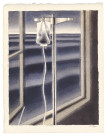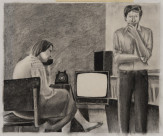The title “Heart Attack” suggests the phone is seen from the angle of a person lying helpless on the floor—the phone serves as a lifeline, but it may be out of reach. Robert pays homage to Alfred Hitchcock’s noir classic, “Dial M for Murder,” in which the phone plays a key role in an attempted murder. The low angle, the moody lighting, the claustrophobic low ceiling and distant doorway help give this banal object an animated presence. The phone, inching off the table, adds to the effect that something is about to happen. Themes of communication, technology and illness prefigure later concerns in the “Illness and Healing” series.
In Psychological Types, 1921, psychologist Carl Jung used the term, participation mystique, to describe the loss of personal ego as one moves toward a more communal or tribal sense of self. But the term is also used when a person identifies with an object, say a “famous blue raincoat.” Imagine someone saying, “my phone is my life.” Our cultural dependence on the current smart phone uses participation mystique in both senses: we identify ourselves with an object, and our need for connectivity, through contact with others, the Internet, the world at large, is part of who we are and how we see ourselves.



